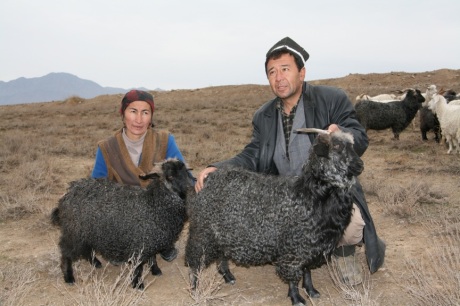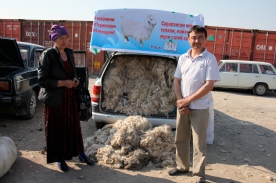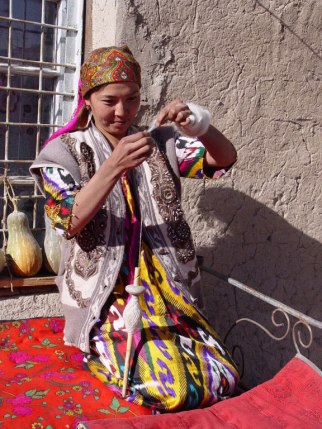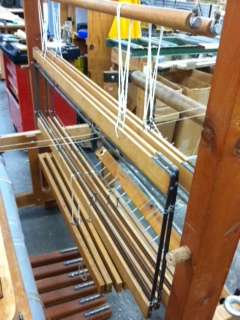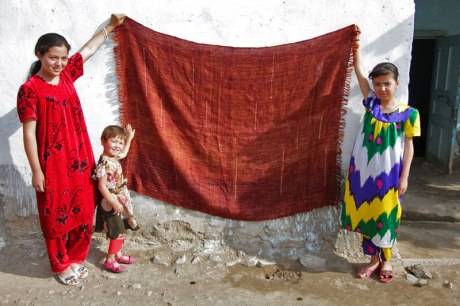This is part two of a post by Cindy Lair’s, Chair of the WARP board, efforts to get a loom to Tajikistan. In the previous post, Cindy talked about helping to get a donated (nonfunctioning) loom to Tajikistan. The loom was destined to assist a group of rural women who weave incredible mohair blanks. Before she tackled the loom project, she wanted to learn as much as possible about the program that would ultimately make use of the loom. By studying this one project, Cindy gives us an insight into the intricacies of international development. To see more photos from the project, visit our Pinterest Page.
The project in Tajikistan focused on a small group of shepherds in the mountainous regions of the country. An effort to improve their breeding stock for fleece weight and quality and to establish small scale fiber processing was started by Dr. Liba Brent, a sociologist from Madison, Wisconsin, under the auspices of the International Fund for Agricultural Development (IFAD).
Hang with me here, there are a lot of long names and complicated cooperative relationships. The IFAD is a specialized agency of the United Nations dedicated to eradicating rural poverty in developing countries. The IFAD has many different grant programs available to fund agricultural related development. One of the available grants is the Community Action in Integrated and Market Oriented Feed-Livestock Production in Central and South Asia. The International Center for Agricultural Research in Dry Areas (ICARDA) is part of a global partnership under the umbrella of the Consultative Group on International Agricultural Research (CGIAR) applied for and received the Feed-Livestock Production grant. ICARDA’s involvement in the region attracted the attention of the Mountain Societies Development Support Programme, a branch of the Aga Khan Development Network dedicated to improving the life of the people of the mountainous oblasts of Tajikistan.
Collectively, all these complicated funding, research, and development agencies and organizations were seeking to promote the rights of women through increased skill development and access to global markets and income opportunities. In particular, one focus of ICARDA’s is value chain management for sheep and goat farming communities in Central Asia. Value chain managment—also called value added agriculture—focus on creating more value at the “farm” gate, so that producers receive more money for their good. Value is added transforming raw goods into finished projects by increasing the quality of the goods that may already be in production.
In the past three years, these collective efforts, have raised the income of participating families by as much as 50%. For example, in 2010, Dr. Brent arranged for semen from the top buck at the 30th Annual Angora Goat Performance Test Sale in Texas. This buck’s clean fleece weight produced 13.1 pounds of fiber with a lock length of 7.2 inches! This hearty fellow helped improve the fiber of the Tajik goats. In turn, the women of the village transform the improved fleece into yarn that they used to weave higher quality blankets. These efforts enhanced women’s standing in their families by enabling them to become wage earners.
As I learned more about this project it became closer to my heart, since a large portion of the project involved not just weaving, but spinning, as well. It motivated me to do my part to get them better tools to support their families. Since they only had one loom that ten weavers had to share, sending them an additional loom essentially allowed them to double their production. How’s that for impact, and all of this was accomplished without every leaving my community.
To purchase yarn from Tajikistan, click here.
For more information about the funding agencies, visit these websites:
IFAD www.ifad.org
ICARDA www.icard.org
Aga Khan Foundation www.akdn.org
To learn more about projects like these, like WARP’s Facebook page. To learn more about WARP, visit our website. To see more photos from Tajikistan, visit our Pinterest page.
